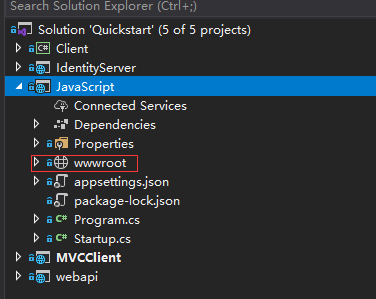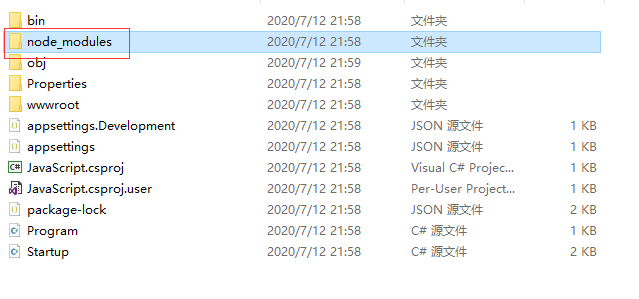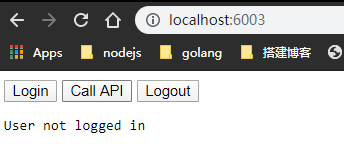【One by One系列】IdentityServer4(五)创建JavaScript客户端
按照OAuth2.0的4种授权方式,接下来应该介绍隐藏式(implicit),与之对应的OpenId Connect Flow的Implicit Flow,但是IdentityServer4官方最新文档没有明言,只是给了Adding a JavaScript client的章节,而且根据内部代码实现,还是采用的授权码,并没有使用Implicit Flow保护SPA,虽然不知道原因,但是我们还是按照官方最新文档的来介绍,在之前的文档,一个版本号为relase的文档,有Implicit Flow的介绍,感兴趣的童鞋,可以读一下,最新的文档编号是latest,从应用的实际代码比较,差别并不大,唯一的差别可能就是原理,但是不去抓包查看相关报文,并无法感觉。
1.创建客户端
这里我们按照官方教程来,使用ASP.NET Core空项目,用内置服务器来承载客户端静态文件。
1.1 创建项目
md JavaScript
cd JavaScript
dotnet new web
dotnet sln add .\JavaScript\JavaScript.csproj
1.2 修改launchSettings.json
{
"profiles": {
"JavaScript": {
"commandName": "Project",
"launchBrowser": true,
"applicationUrl": "http://localhost:6003",
"environmentVariables": {
"ASPNETCORE_ENVIRONMENT": "Development"
}
}
}
}
1.3 添加 ‘静态文件中间件’
该项目是为客户端运行而设计的,我们只需要ASP.NET Core提供构成我们的应用程序的静态HTML和JavaScript文件,静态文件中间件就是为此设计的。
注册静态文件中间件,同时删除其他代码。
Startup.Configure
public void Configure(IApplicationBuilder app)
{
app.UseDefaultFiles();
app.UseStaticFiles();
}
这个中间件现在将提供应用程序的~/wwwroot文件夹中的静态文件。这是我们将放置HTML和JavaScript文件的地方。空项目中不存这个目录,所以需要创建这个目录。

1.4 oidc-client library下载
在上篇,我们使用了一个库去处理OpenID Connect 协议,在JavaScript中,我们同样需要类似的库,只不过现在需要这个库能够在JavaScript中使用且浏览器运行(因为node.js是服务端),https://github.com/IdentityModel/oidc-client-js
我们用npm下载
npm i oidc-client
copy .\node_modules\oidc-client\dist\* .\wwwroot\

1.5 添加html和js文件
两个html文件和一个除上面的oidc-client之外的js文件组成我们JavaScript应用(SPA)
- index.html
- callback.html
- app.js
index.html
<!DOCTYPE html>
<html>
<head>
<meta charset="utf-8" />
<title></title>
</head>
<body>
<button id="login">Login</button>
<button id="api">Call API</button>
<button id="logout">Logout</button>
<pre id="results"></pre>
<script src="oidc-client.js"></script>
<script src="app.js"></script>
</body>
</html>
3个登录按钮,引入两个js文件
app.js
function log() {
document.getElementById('results').innerText = '';
Array.prototype.forEach.call(arguments, function (msg) {
if (msg instanceof Error) {
msg = "Error: " + msg.message;
}
else if (typeof msg !== 'string') {
msg = JSON.stringify(msg, null, 2);
}
document.getElementById('results').innerHTML += msg + '\r\n';
});
}
//register click event handlers to the three buttons
document.getElementById("login").addEventListener("click", login, false);
document.getElementById("api").addEventListener("click", api, false);
document.getElementById("logout").addEventListener("click", logout, false);
//UserManager from the oidc-client to manage the OpenID Connect protocol
var config = {
authority: "http://localhost:5001",
client_id: "js",
redirect_uri: "http://localhost:6003/callback.html",
response_type: "code",
scope: "openid profile api1",
post_logout_redirect_uri: "http://localhost:6003/index.html",
};
var mgr = new Oidc.UserManager(config);
/*
* UserManager provides a getUser API to know if the user is
* logged into the JavaScript application.
* It uses a JavaScript Promise to return the results asynchronously.
* The returned User object has a profile property which contains
* the claims for the user.
* Add this code to detect if the user is logged into
* the JavaScript application:
*/
mgr.getUser().then(function (user) {
if (user) {
log("User logged in", user.profile);
}
else {
log("User not logged in");
}
});
function login() {
mgr.signinRedirect();
}
function api() {
mgr.getUser().then(function (user) {
var url = "http://localhost:6001/api/identity";
var xhr = new XMLHttpRequest();
xhr.open("GET", url);
xhr.onload = function () {
log(xhr.status, JSON.parse(xhr.responseText));
}
xhr.setRequestHeader("Authorization", "Bearer " + user.access_token);
xhr.send();
});
}
function logout() {
mgr.signoutRedirect();
}
- 对3个按钮进行监听,并触发不同的事件:addEventListener
- 登录
- 退出
- 调用api
callback.html
这个HTML文件是用户登录到IdentityServer后指定的redirect_uri页面,它将与IdentityServer完成OpenID Connect协议的登录握手。此代码全部由我们在app.js中使用的UserManager类提供。登录完成后,我们可以将用户重定向回主页面index.html。
<!DOCTYPE html>
<html>
<head>
<meta charset="utf-8" />
<title></title>
</head>
<body>
<script src="oidc-client.js"></script>
<script>
new Oidc.UserManager({response_mode:"query"}).signinRedirectCallback().then(function() {
window.location = "index.html";
}).catch(function(e) {
console.error(e);
});
</script>
</body>
</html>
2.在IdentityServer注册客户端
客户端应用已经准备好,像其他的客户端一样,需要IdentityServer中添加客户端
// JavaScript Client
new Client
{
ClientId = "js",
ClientName = "JavaScript Client",
// 注意看这里,GrantTypes还是选择的Code
// GrantTypes.Implicit,
AllowedGrantTypes = GrantTypes.Code,
RequireClientSecret = false,
RedirectUris = { "http://localhost:6003/callback.html" },
PostLogoutRedirectUris = { "http://localhost:6003/index.html" },
AllowedCorsOrigins = { "http://localhost:6003" },
AllowedScopes =
{
IdentityServerConstants.StandardScopes.OpenId,
IdentityServerConstants.StandardScopes.Profile,
"api1"
}
}
3.允许ajax跨域调用webapi
这个就需要在webapi项目中增加跨域配置
Startup.ConfigureServices
services.AddCors(options =>
{
// this defines a CORS policy called "default"
options.AddPolicy("default", policy =>
{
policy.WithOrigins("http://localhost:6003")
.AllowAnyHeader()
.AllowAnyMethod();
});
});
添加CORS中间件
public void Configure(IApplicationBuilder app)
{
app.UseRouting();
app.UseCors("default");
// ...
}
更多跨域配置,参考官方文档
4.测试
运行IdentityServer
cd .\IdentityServer\
dotnet run
运行webapi
cd .\webapi\
dotnet run
VS运行SPA
启动内置服务器,搭载静态文件


登录成功

调用api

注销登录

参考链接
http://docs.identityserver.io/en/latest/quickstarts/4_javascript_client.html
作者:Garfield
同步更新至个人博客:http://www.randyfield.cn/
本文版权归作者所有,未经许可禁止转载,否则保留追究法律责任的权利,若有需要请联系287572291@qq.com
微信公众号
扫描下方二维码关注个人微信公众号,实时获取更多干货



 浙公网安备 33010602011771号
浙公网安备 33010602011771号